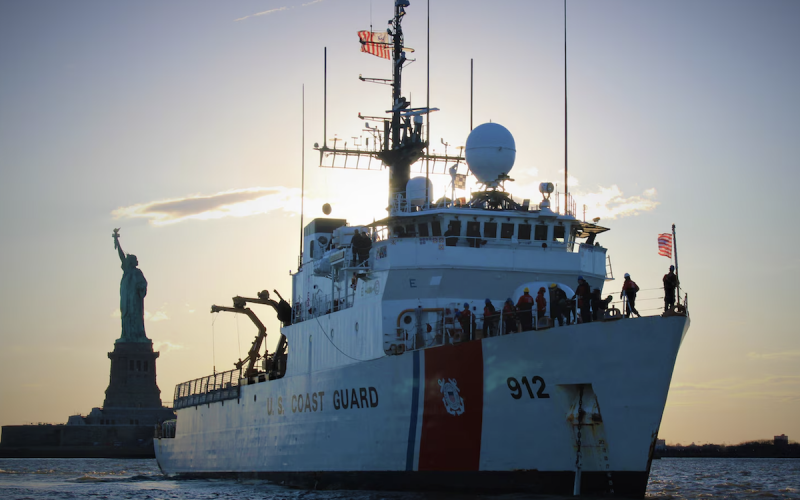The U.S. Coast Guard is making headway addressing recruiting and retention challenges, but progress will remain slow unless the service makes significant changes in the culture of the organization and receives more money from Congress to widen recruiting efforts, upgrade its programs and infrastructure and implement and oversee internal reforms.
The service is 10% or about 4,800 people short of what it needs to be at full manpower to perform its many missions. The shortage is especially acute in missions involving cyberspace and marine inspection and is expected to grow through this year.
“This is one of the largest workforce shortages in the Coast Guard’s 233-year history, and it is significantly impacting our daily operations,” Vice Admiral Paul F. Thomas, deputy commandant for mission support, told a congressional hearing earlier this month. “While we continue to work to bolster recruiting efforts, improve retention and make risk-based adjustments to operations, the workforce is feeling the strain.”
The shortage has led the Coast Guard to temporarily deactivate some vessels ahead of schedule and consolidate 19 units under a “force realignment initiative.” Emphasis will be on lifesaving missions, national security and protecting the marine transportation system. Beginning this summer, seasonal stations will transition into other nearby unit locations, operations at western river units will be paused and manning at stations with overlapping coverage will be reduced. All these changes are temporary and reversible, the admiral said.
To attract recruits, the service has relaxed some entry requirements to make more candidates eligible and modernized recruiting, retention and training programs. New steps include making it easier for green card holders to enlist, opening seven new recruiting offices, allowing single parents to join, employing virtual recruiters and a dedicated call center, partnering with maritime training schools, targeting marketing to online social platforms like Twitch, a gaming site, and expanding recruiting into different geographic areas.
“We have invested in recruiting and we’re meeting new recruits where they are,” Coast Guard Commandant Adm. Linda Fagan said in her second annual State of the Coast Guard address on March 20. “We now train newly enlisted service members in their technical specialty by assessing the skills and abilities they already have, then create a customized curriculum. This tailored approach is paying dividends. This past year, 149 new petty officers graduated from technical training 31% faster and reported to frontline Coast Guard operations that much sooner.”
To retain current Coasties, the service is beefing up its support programs by allowing co-location of dual military families, improving access to healthcare, enhancing parental leave, and expanding childcare subsidies, among other changes.
Concerned that the labor shortage will hurt Coast Guard operations, Congress is considering actions in the Coast Guard Authorization Act of 2024 that would authorize $12 million for the next two fiscal years to bring on more recruiters and open new offices, and $9 million to boost Coast Guard recruiting programs.
Hiring challenges partly reflect a nationwide labor shortage that has made it difficult for every military branch and just about every industry to fill vacant positions and retain current employees.
But the Coast Guard also faces a recruiting and retention hurdle of its own making: failing to publicly acknowledge and respond swiftly to a raft of complaints of sexual harassment and abuse has rattled trust in the organization, put into question its commitment to transparency and accountability, and made it harder to recruit new hires.
At issue is the improper handling and secrecy of “Operation Fouled Anchor,” an internal investigation into misconduct at the Coast Guard Academy that occurred between 1990 and 2006. The investigation revealed a pattern of mishandling a raft of sexual harassment and assault cases, leading to perpetrators not being held accountable and victims not being treated with respect or given proper attention to their complaints.
The report’s findings were kept secret, an apparent attempt to protect the Academy and the Coast Guard rather than helping the victims. Congress and the public didn’t find out about the report until it was leaked to the news media. In response last July, Adm. Fagan, who was not in charge at the time of the incidents, directed that a 90-day review of current policies, organizational culture and laws produce actionable reforms.
Containing 30 recommended actions, the report was released in November, and the challenge ahead is to implement and oversee the recommended changes.
So far, five of these actions have been completed, nine will be done soon and 14 will take six months to a year, while the remaining require a lot of investments and will take longer, Adm. Thomas told the congressional hearing. Congress plans to oversee how this develops. “We’re focused on restoring trust,” the admiral said. “We’ve lost the trust with this committee, with the American public and with our workforce.”
Another factor affecting recruiting is the crumbling condition of infrastructure at Coast Guard training centers and the Academy.
“We need to modernize the Coast Guard Academy and our boot camp. Compared to West Point and (the U.S. Naval Academy at) Annapolis, our facilities can’t match up, so we definitely need to invest there,” Thomas told lawmakers.
The Coast Guard authorization bill now working its way through Congress would address many of these shortfalls by authorizing improvements to the Coast Guard Training Center in Cape May, N.J., creation of a new infrastructure plan and repairs at the Academy and improvements at several Coast Guard bases across the country.




